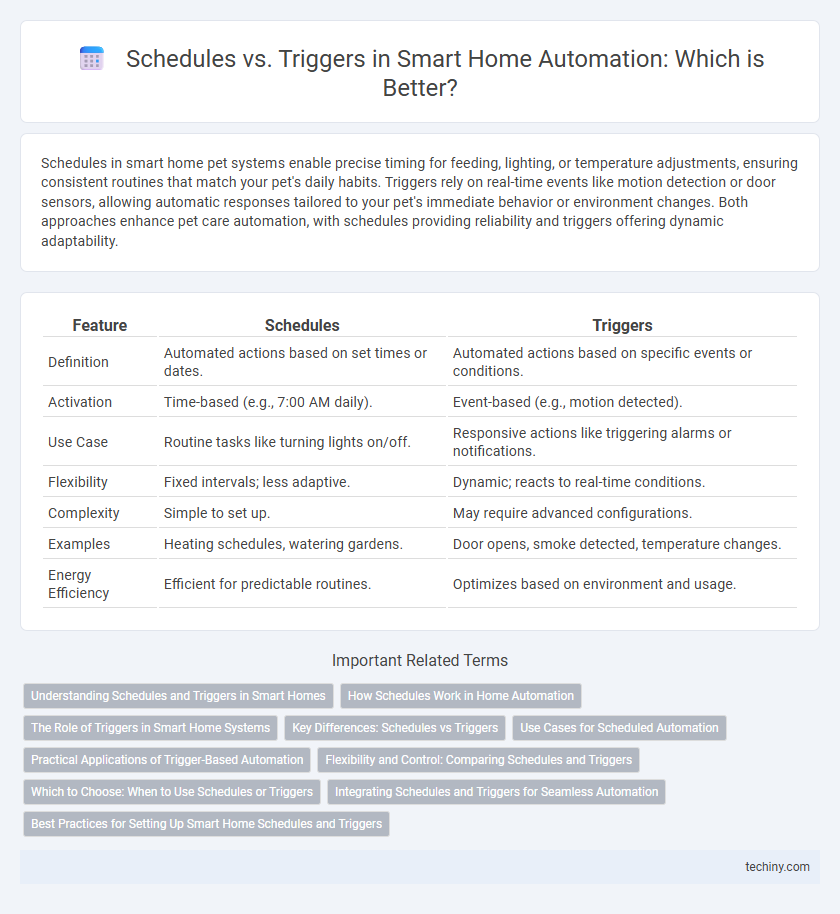Schedules in smart home pet systems enable precise timing for feeding, lighting, or temperature adjustments, ensuring consistent routines that match your pet's daily habits. Triggers rely on real-time events like motion detection or door sensors, allowing automatic responses tailored to your pet's immediate behavior or environment changes. Both approaches enhance pet care automation, with schedules providing reliability and triggers offering dynamic adaptability.
Table of Comparison
| Feature | Schedules | Triggers |
|---|---|---|
| Definition | Automated actions based on set times or dates. | Automated actions based on specific events or conditions. |
| Activation | Time-based (e.g., 7:00 AM daily). | Event-based (e.g., motion detected). |
| Use Case | Routine tasks like turning lights on/off. | Responsive actions like triggering alarms or notifications. |
| Flexibility | Fixed intervals; less adaptive. | Dynamic; reacts to real-time conditions. |
| Complexity | Simple to set up. | May require advanced configurations. |
| Examples | Heating schedules, watering gardens. | Door opens, smoke detected, temperature changes. |
| Energy Efficiency | Efficient for predictable routines. | Optimizes based on environment and usage. |
Understanding Schedules and Triggers in Smart Homes
Schedules in smart homes allow users to automate actions based on predefined time settings, enabling devices to operate at specific hours for convenience and energy efficiency. Triggers activate smart devices in response to events or changes in the environment, such as motion detection or door opening, enhancing security and responsiveness. Understanding the distinction between schedules and triggers helps optimize smart home automation by combining timed routines with real-time event detection.
How Schedules Work in Home Automation
Schedules in home automation operate by programming devices to perform specific actions at predefined times, enhancing convenience and energy efficiency. These preset timers use a 24-hour clock or calendar-based input to activate lights, thermostats, or security systems automatically without manual intervention. By integrating with smart hubs, schedules ensure consistent execution of routines, optimizing daily home management and reducing energy consumption.
The Role of Triggers in Smart Home Systems
Triggers play a crucial role in smart home systems by enabling automated responses based on specific events or conditions, such as motion detection, time of day, or sensor data. These event-driven actions enhance convenience, security, and energy efficiency by activating devices only when necessary. Unlike fixed schedules, triggers offer dynamic and context-aware automation, adapting to real-time changes in the environment.
Key Differences: Schedules vs Triggers
Schedules in smart home systems automate actions based on specific times or dates, enabling routines like turning lights on at sunset or adjusting thermostats every morning. Triggers activate devices in response to events or conditions such as motion detection, door opening, or changes in temperature, providing real-time responsiveness. Key differences lie in timing precision--schedules operate on fixed intervals while triggers depend on environmental inputs--making schedules ideal for regular tasks and triggers essential for dynamic, event-driven automation.
Use Cases for Scheduled Automation
Scheduled automation in smart homes enables precise control over lighting, heating, and security systems based on predefined times, enhancing energy efficiency and convenience. For example, thermostats can adjust temperatures before residents wake up, and lights can turn off automatically at bedtime to save power. This approach ensures routine tasks are managed seamlessly without manual input, improving overall home management.
Practical Applications of Trigger-Based Automation
Trigger-based automation in smart homes enables devices to respond instantly to specific events, such as motion detection turning on lights or a door sensor activating an alarm system. Unlike fixed schedules, triggers provide adaptive control that enhances security, energy efficiency, and convenience by reacting in real time to environmental changes or user actions. This dynamic approach supports advanced scenarios like adjusting thermostat settings based on occupancy or launching routines when a smartphone connects to the home Wi-Fi network.
Flexibility and Control: Comparing Schedules and Triggers
Schedules in smart homes provide predictable automation by executing actions at predefined times, ensuring consistent control over devices. Triggers offer dynamic flexibility by responding to real-time events or sensor inputs, enabling adaptive and context-aware automation. Combining schedules and triggers maximizes control, allowing homeowners to customize environments with both precise timing and responsive interactions.
Which to Choose: When to Use Schedules or Triggers
Schedules in smart homes are ideal for routine tasks like turning lights on at sunset or adjusting thermostats at bedtime, providing consistency and energy efficiency. Triggers are better suited for dynamic responses, such as activating security cameras when motion is detected or adjusting lighting when a door opens. Choosing between schedules and triggers depends on whether the desired action is time-based or event-driven, optimizing convenience and automation accuracy.
Integrating Schedules and Triggers for Seamless Automation
Integrating schedules and triggers in smart home automation enables a seamless experience by combining time-based routines with real-time sensor data for adaptive responses. Schedules allow pre-set actions like lighting or temperature adjustments at specific times, while triggers activate events based on environmental changes such as motion detection or door openings. Leveraging both enhances efficiency and personalization by ensuring devices operate precisely when needed, optimizing energy use and convenience.
Best Practices for Setting Up Smart Home Schedules and Triggers
Effective smart home automation relies on well-defined schedules and triggers to optimize convenience and energy efficiency. Best practices include setting schedules based on your daily routine and environmental factors, such as adjusting lighting and thermostat settings during peak hours or weather changes. Triggers should be configured using sensors and geo-fencing technology to enable real-time responses like activating security cameras when motion is detected or turning off appliances when you leave home.
Schedules vs Triggers Infographic

 techiny.com
techiny.com